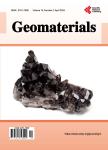Effect of the Number and Orientation of Fractures on the P-Wave Velocity Diminution: Application on the Building Stones of the Rabat Area (Morocco)
Effect of the Number and Orientation of Fractures on the P-Wave Velocity Diminution: Application on the Building Stones of the Rabat Area (Morocco)作者机构:Université Mohammed V-Agdal (Maroc) Faculté des Sciences Département de Géologie Rabat Morocco Université Mohammed V-Agdal (Maroc) Institut Scientifique Département des Sciences de la Terre Equipe de Géomatériaux et Géo-Environnement (GeoM&E) Rabat Morocco
出 版 物:《Geomaterials》 (地质材料(英文))
年 卷 期:2013年第3卷第3期
页 面:71-81页
学科分类:1002[医学-临床医学] 100214[医学-肿瘤学] 10[医学]
主 题:Fracture Diminution P-Wave Velocity Calcarenite Marble Morocco
摘 要:This study is focused on two types of Moroccan rocks, among the most widely used as building stones: the calcarenite of Salé (CS) and the marble of oued Akrech (MA). The two rocks, lithologically different, show a clear contrast of their P-wave velocities (Vp): 3.90 vs 5.10 km/s at dry state and 4.29 vs 5.64 km/s at saturation. The “Artificial fractures created in the two rock types reveal that their Vp undergo diminutions which the rates vary depending of the number and the plane orientation of the fractures. In the CS, Vp shows an increasing of cumulative diminution (Dc) according to the number of fractures, but with a variable rate of unitary diminution (Du) from one fracture to the other. This defines a linear regression with a low coefficient of determination (Dc = 10.18NbFr + 10.96;r2 = 0.87). The mode of the Vp evolution would be related to the roughness of fractures surface, which itself depends upon the petrographic nature of the calcarenite (friable structure, high porosity and heterogenous composition). The MA manifested an increasing Dc with a fairly constant rate of Du from a fracture to another, giving a regression line with a high coefficient of determination (Dc = 12.17NbFr – 10.69;r2 = 0.99). This steady diminution of Vp would be related to the granoblastic texture and the monomineral composition of the marble, which engender smoother fracture surfaces. The rates of Vp diminution also depend on the orientation plane of the fractures relative to the direction of wave propagation. The fractures parallel (θ = 0°) amplify slightly the Vp, playing a significant role of “waveguide. The fractures oriented at 45° lead to a diminution lower than those of fractures oriented at 25° and 90°. The same trend of diminution, but at variable rates, appears on the samples of the two types of stones at dry and saturated state. This can be explained by the compressive nature of P-waves, which obey the physic laws of the transmission of the constraints in the solid me



